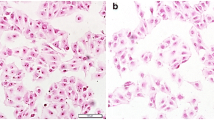Abstract
Nanoparticle realgar powders (NRP) inhibited U937 cell growth in a time and dose-dependent manner. U937 cells treated with NRP showed typical characteristics of apoptosis including the morphological changes and DNA fragmentation. Caspase family inhibitor (z-VAD-fmk), caspase-8, -9 inhibitor (z-IETD-fmk, Ac-LEHD-CHO, respectively) and caspase-3 inhibitor (z-DEVD-fmk) partially prevented NRP -induced apoptosis. Moreover, the classical substrates of caspase-3, poly-ADP ribose polymerase (PARP) was degraded after U937 cells treatment with NRP. In addition, NRP increased the ratio of Bax/Bcl-2 protein expression. Although p38 inhibitor (SB203580) and ERK inhibitor (PD98059) failed to block cell death, JNK inhibitor (SP600125) had marked inhibitory effects on NRP -induced apoptosis. Furthermore, the phosphorylation of JNK was up-regulated, suggesting that JNK was responsible for NRP -induced apoptosis in U937 cells. These results suggested that the caspase, mitochondria and MAPK signal pathways were involved in NRP-induced U937 apoptosis.
Similar content being viewed by others
References
Bernardi, P., Broekemeier, K. M., and Pfeiffer, D. R., Recent progress on regulation of the mitochondrial permeability transition pore; a cyclosporin-sensitive pore in the inner mitochondrial membrane.J. Bioenerg. Biomembr., 26, 509–517 (1994).
Deng, Y., Xu, H., Huang, K., Yang, X., Xie, C., and Wu, J., Size effects of realgar particles on apoptosis in a human umbilical vein endothelial cell line.Pharmacol. Res., 44, 513–518 (2001).
Enari, M., Sekahira, H., Yokoyama, H., Okawa, K., Iwamatsu, A., and Nagata, S., A caspase-activated DNase that degrades DNA during apoptosis and its inhibitor ICAD.Nature, 391, 43–49 (1998).
Hill, P. A., Tumber, A., and Meikle, M. C., Multiple extracellular signals promote osteoblast survival and apoptosis.Endocrinology, 138, 3849–3858 (1997).
Kawazoe, N., Watabe, M., Masuda, Y., Nakajo, S., and Nakayo, K., Tiamil is involved in the regulation of bufalin-induced apoptosis in human leukemia cells.Oncongene, 18, 2413–2421 (1999).
Kirsch, D. G., Doseff, A., Nelson-Chau, B., Lim, D. S., Souza-Pinto, N. C., and Hansford, R., Caspase-3-dependent cleavage of bcl-2 promotes release of cytochrome c.J. Biol. Chem., 274, 21155–21161 (1999).
Mandal, M., Maggirwar, S. B., Sharma, N., Kaufmann, S. H., Sun, S. C., and Kumar, R., Bcl-2 prevents CD95 (Fas/APO- 1)-induced degradation of Lamin B and poly (ADP-ribose) polymerase and restores the NF-êB signaling pathway.J. Biol. Chem., 271, 30354–30359 (1996).
Mizukami, S., Kikuchi, K., Higuchi, T., Urano, Y., Mashima, T., and Tusuruo, T., Imaging of caspase-3 activation in HeLa cells stimulated with etoposide using a novel fluorescent probe.FEBS Lett., 453, 356–360 (1999).
Nicholson, D. W., Ali, A., Thornberry, N. A., Vaillancourt, J. P., Ding, C. D., Gallant, M., Gareau, Y., Griffin, P. R., Labelle, M., and Lazebnik, Y. A., Identification and inhibition of the ICE/ CED-3 protease necessary for mammalian apoptosis.Nature (London), 376, 37–43 (1995).
Pastorino, J. G., Chen, S. T., Tafani, M., Snyder, J. W., and Farber, J. L., The overexpression of Bax produces cell death upon induction of the mitochondrial permeability transition.J. Biol. Chem., 273, 7770–7775 (1998).
Scrinivasan, A., Li, F., Wong, A., Kodandapani, L., Smidt, R., Krebs, J. F., Fritz, L. C., Wu, J. C., and Tomaselli, K. J., Bcl-xL functions downstream of caspase-8 to inhibit Fas-and tumor necrosis factor receptor 1-induced apoptosis of MCF7 breast carcinoma cells.J. Biol. Chem., 273, 4523–4529 (1998).
Yu, S. W., Wang, H., Poitras, M. F., Coombs, C., Bowers, W. J., Federoff, H. J., Poirier, G. G., Dawson, T. M., and Dawson, V. L., Mediation of poly (ADP-Ribose) polymerase-1-dependent cell death by apoptosis-inducing factor.Science, 297, 259–263 (2002).
Wang, X. B., Xi, R. G., Yao, W., and Lin, Y., Study on pharmacokinetics of nanoparticle realgar.Pharm. J. Chin. PLA, 18, 324–326 (2002).
Wang, X. B., Xi, R. G., Zhang, Zh. R., Wang, J. G., and Yao, W., Therapeutic mechanism on leukemia and clinical application of arsenic realgaret al.Pharm. J. Chin. PLA, 19, 129–132 (2003).
Xia, Z. G., Dikens, M., Raingesud, J., Davis, R. J., and Greenberg, M. E., Opposing effects of ERK and JNK-p38 MAP kinases on apoptosis.Science, 270, 1336–1341 (1995).
Zhang, Y. K., Fujita, N., and Tsuruo, T., Caspase-mediated cleavage of p21Waf1/Cip1 converts cells from growth arrest to undergoing apoptosis.Oncongene, 18, 1131–1138 (1999).
Zoratti, M. and Szabo, I., The Mitochondrial permeability transition.Biochim. Biophys., 1241, 139–176 (1995).
Author information
Authors and Affiliations
Corresponding author
Rights and permissions
About this article
Cite this article
Wang, Xb., Gao, Hy., Hou, Bl. et al. Nanoparticle realgar powders induce apoptosis in u937 cells through caspase mapk and mitochondrial pathways. Arch Pharm Res 30, 653–658 (2007). https://doi.org/10.1007/BF02977662
Received:
Issue Date:
DOI: https://doi.org/10.1007/BF02977662




